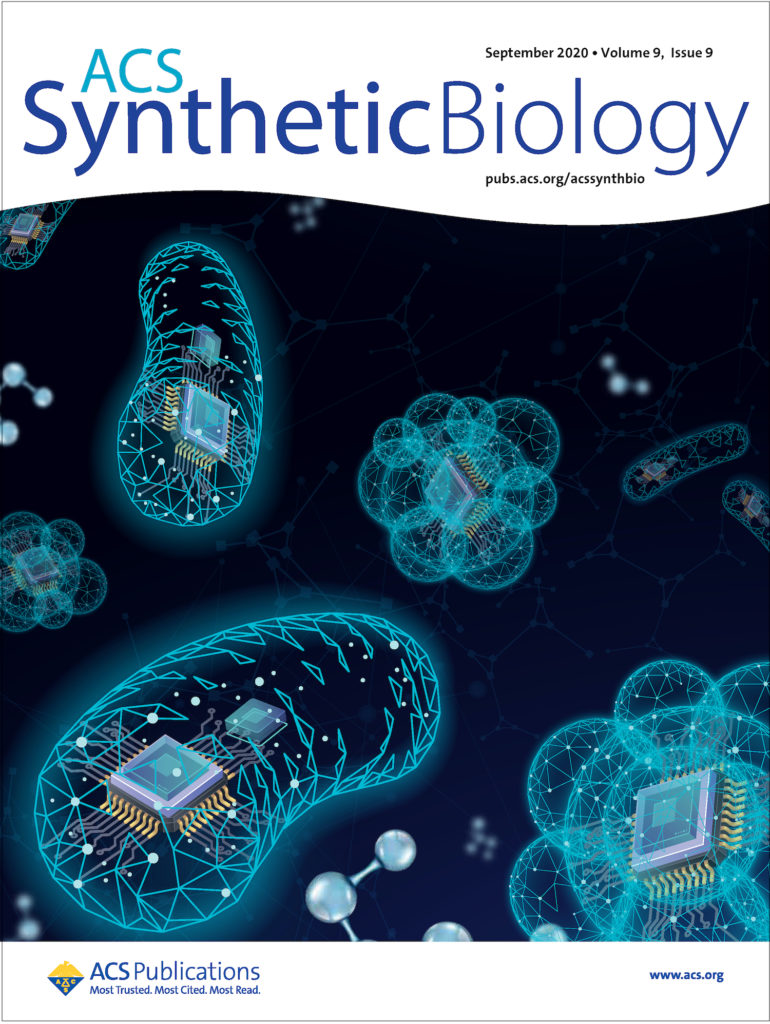A group led by JGI scientists have made strides in improving and applying a method that allows researchers to quickly modify diverse bacterial genomes.

JGI-developed genetic engineering technique CRAGE lands the cover of ACS Synthetic Biology. (Wayne Keefe/Berkeley Lab)
In 2019, the JGI’s Yasuo Yoshikuni and his team announced in Nature Microbiology an important addition to the synthetic biologist’s toolkit: a technique for chassis (or strain)-independent recombinase-assisted genome engineering (CRAGE). CRAGE enables scientists to insert large pieces of DNA (up to 60 kb) in a single step, directly into the genome.
“CRAGE is central to our ability to offer host-engineering for our users,” says JGI Director Nigel Mouncey. Using CRAGE, JGI has established a portfolio of microbial hosts that users can select to be engineered. “Piloting access to this emerging technology with JGI users will enable us to assess CRAGE’s impact, including how this application could scale,” says Mouncey.
The JGI team has already demonstrated CRAGE as a versatile engineering system that allows scientists to conduct genome-wide screens and explore biosynthetic pathway. Thus far, the JGI has deployed CRAGE to successfully domesticate some 60 strains, inserting into them a genetic sequence that acts as a “landing pad.” Mouncey adds, “Once you have a landing pad in a strain, you can deliver multiple types of payloads, such as individual genes, whole pathways, genome-editing tools, and reporters.”
For example, the JGI first used CRAGE to engineer domesticated bacterial strains with novel biosynthetic gene clusters (BGCs). BGCs make diverse molecules of value to both human and ecosystem health. But bacteria often fail to express their BGC molecules in the lab. By engineering domesticated close relatives with the BGCs, JGI scientists could relieve BGCs from their former genetic repression, enabling scientists to see what molecules they produce. For more on this feat, see this Lawrence Berkeley National Laboratory (Berkeley Lab) Newscenter story and this piece in Current Opinion in Biotechnology.
Now, CRAGE is being applied to other synthetic biology problems. For example, a group of JGI users led by Steven Hallam at the University of British Columbia, recently deployed CRAGE to rapidly label E. coli in order to monitor population dynamics in co-culture. These experiments aim to inform the engineering of stable, synthetic microbial communities to take advantage of their joint metabolisms. Because, together, microbes can be used to create compounds more efficiently than one strain could on its own. In work published in Synthetic Biology, the team used CRAGE to insert a fluorescent marker into E. coli, allowing the team to model the competition dynamics between different synthetic E. coli strains in co-culture.
Yoshikuni, Matt Blow, and their team have also harnessed CRAGE to create a plant-fertilizing microbiome. In work reported in Applied and Environmental Microbiology, the researchers engineered root bacteria Pseudomonas and Ralstonia with enzymes that make phosphate bioavailable for plants. When these engineered bacteria were used with the model plant Arabidopsis, the plants grew better than when they were grown with non-engineered strains. Their work puts into practice ideas presented in a Trends in Biotechnology review piece by Yoshikuni and JGI colleagues Jing Ke and Bing Wang.
Yoshikuni’s team has also recently upgraded the CRAGE technology. Instead of only accommodating one DNA insertion, the new system, CRAGE-Duet, can accommodate two DNA constructs, doubling the amount of DNA that can be inserted at a time. In a project detailed in ACS Synthetic Biology, Yoshikuni and JGI’s Jan-Fang Cheng and Trent Northen teamed with longtime JGI collaborator Jeffery Dangl at the University of North Carolina at Chapel Hill, using CRAGE-Duet to engineer Pseudomonas simiae with fluorescent markers to visualize the bacterium colonizing plant roots — a proof-of-principle for investigating plant-microbe interactions.
A final recent advance in CRAGE is the addition of CRISPR enzyme Cas9. Originally, CRAGE was only used to insert genes of interest. But now, with Cas9, CRAGE can be used for precise genome editing. This means that scientists can modify gene expression, or delete genes, all with the rapid engineering capability of CRAGE. Cheng and his team demonstrated the use of Cas9 with CRAGE in PLOS One, engineering different gene deletions in four gammaproteobacterial species, and then removing the editing machinery afterward seamlessly.
These collaborations and technical advances demonstrate that CRAGE is all the rage – and interested researchers can now request this capability. Scientists can apply to use CRAGE in a select group of bacterial strains as part of the Community Science Program (CSP) Functional Genomics proposal call.
Relevant Links:
- Industry partnership utilizing CRAGE
- JGI Video on CRAGE (also below), which delves into the technology’s molecular mechanisms.